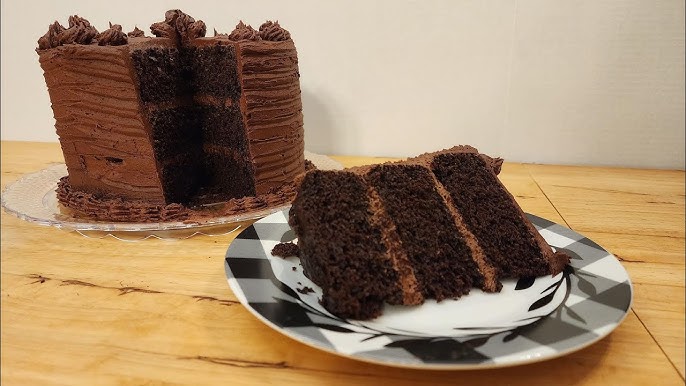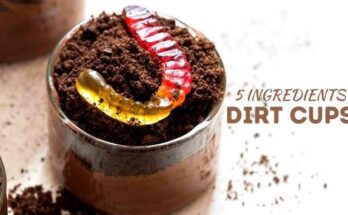Depression Cake Recipe: Depression Cake, also known as Wacky Cake or Crazy Cake, is a simple yet delightful dessert that dates back to the Great Depression era of the 1930s. During this difficult time, many households had to cook and bake with limited resources, meaning luxuries like eggs, milk, and butter were hard to come by. Despite the lack of traditional baking staples, people found creative ways to make delicious desserts using pantry essentials. Depression Cake is the result of that ingenuity—it’s eggless, dairy-free, and butter-free, yet it comes out moist, fluffy, and full of flavor.
This cake stands out for its simplicity. Unlike modern cakes that often require multiple mixing bowls, electric mixers, or complex steps, Depression Cake is made with just one bowl and a spoon. You don’t even need fancy equipment. Its rich chocolate flavor and soft texture prove that you don’t need expensive ingredients to make something comforting and indulgent.
What makes it even more charming is its history. It’s not just a recipe; it’s a symbol of resilience. Families during hard economic times made the best of what they had, and this cake is a reminder that joy can still be created with little. Even today, it remains a favorite because it’s budget-friendly, vegan-friendly, and quick to prepare—making it timeless in every sense.
The History Behind the Recipe
The Great Depression, which lasted from 1929 to the late 1930s, brought widespread poverty. During this time, rationing was common, and families learned to stretch meals with inexpensive ingredients. Eggs and milk were often considered luxuries, so bakers turned to alternatives like vinegar and baking soda to help cakes rise. Oil replaced butter for moisture, and cocoa powder provided a rich flavor that made up for the absence of cream or chocolate bars.
Recipes like Depression Cake were often shared among neighbors, churches, and communities. They weren’t just about feeding families—they were about lifting spirits. Imagine being able to serve a sweet treat during tough times; it was a small way to bring happiness to the dinner table.
Over the decades, the cake earned several nicknames. Some called it Wacky Cake because of the unusual method of mixing everything directly in the baking pan. Others called it Crazy Cake, perhaps because it defied traditional baking rules yet still tasted amazing. No matter the name, the recipe became a piece of culinary history, passed down through generations.
Why Depression Cake is Still Popular Today
Fast forward to today, Depression Cake is enjoying a revival. Why? Because it checks so many boxes for modern-day home bakers. First, it’s budget-friendly. In times when grocery prices can be unpredictable, this cake proves you don’t need expensive ingredients to make something delicious.
Second, it’s vegan without needing substitutions. Unlike many cake recipes where you need flaxseed eggs or plant-based milk to replace animal products, Depression Cake naturally avoids them. This makes it perfect for anyone who follows a plant-based lifestyle or has food allergies.
Third, it’s ridiculously easy to make. Whether you’re a beginner baker or just short on time, this recipe saves you the trouble of multiple mixing steps. You can literally throw the ingredients into the pan, mix them together, and bake—no fuss required.
And lastly, it’s delicious. Its deep chocolate flavor and tender crumb can rival more complicated cakes. Some people even say it tastes better the next day after the flavors have had time to settle.
Ingredients You’ll Need
Core Ingredients
The beauty of Depression Cake lies in its simplicity. You don’t need a long shopping list; most of these items are probably already in your pantry. Here’s what you’ll need for the basic recipe:
- All-purpose flour – the foundation of the cake.
- Granulated sugar – adds sweetness and balances the cocoa.
- Unsweetened cocoa powder – gives that deep chocolate flavor.
- Baking soda – helps the cake rise.
- Salt – enhances the flavor.
- Vegetable oil – keeps the cake moist.
- Vinegar – reacts with baking soda to create lift.
- Vanilla extract – adds aroma and flavor depth.
- Water – the liquid base that binds everything together.
That’s it! No eggs, no milk, no butter. The combination of vinegar and baking soda acts as a natural leavening agent, replacing eggs, while oil ensures moisture.
Optional Add-ins for Extra Flavor
While the classic recipe is perfect as is, you can always customize it to suit your taste:
- Chocolate chips – for a richer, fudgier texture.
- Nuts (walnuts, pecans, or almonds) – for crunch.
- Dried fruits (raisins, cranberries, or cherries) – for sweetness.
- Spices like cinnamon or nutmeg – for warmth and depth.
- Espresso powder – to enhance the chocolate flavor.
These add-ins can take the cake to the next level, turning a humble recipe into something more decadent without losing its simplicity.
Ingredient Substitutions for Dietary Needs
One of the reasons Depression Cake remains so loved is its flexibility. If you’re following specific dietary needs, here are some easy swaps:
- Gluten-free flour – replace all-purpose flour with a 1:1 gluten-free blend.
- Natural sweeteners – swap sugar for coconut sugar or maple syrup.
- Oil alternatives – try applesauce or mashed bananas for a lower-fat version.
- Flavored extracts – swap vanilla for almond, orange, or peppermint extract for a twist.
This adaptability makes it a cake for everyone—whether you’re vegan, gluten-free, or simply looking for a healthier version.
Tools and Equipment
Basic Kitchen Tools
Another reason Depression Cake is such a favorite is because you don’t need fancy tools. Here’s the basic equipment required:
- Mixing bowl (or just the baking dish if you’re doing the one-pan method).
- Measuring cups and spoons.
- Whisk or spoon for mixing.
- 8×8-inch or 9×9-inch baking dish.
- Oven (preheated to 350°F / 175°C).
That’s it. No mixer, no special gadgets. Just simple tools you already have in your kitchen.
Alternatives if You Don’t Have Baking Equipment
What if you don’t have some of the traditional baking tools? Don’t worry, this recipe is flexible:
- No whisk? A fork works fine.
- No square baking dish? Use a round cake pan or even a loaf pan.
- No oven? Believe it or not, Depression Cake can be steamed on the stovetop. Just place the batter in a heatproof dish, cover, and steam for about an hour until cooked through.
This flexibility is another reason the cake has stood the test of time—it was designed for households that didn’t always have the best equipment, and it still works today.
Step-by-Step Guide to Making Depression Cake
Step 1 – Preparing Your Baking Dish
Before you dive into mixing ingredients, the first step is preparing your baking dish. Preheat your oven to 350°F (175°C). Grease your baking pan lightly with oil, or line it with parchment paper for easy removal. Some bakers like to make the cake directly in the pan without greasing, which is actually part of the original recipe method.
Once your dish is ready, set it aside—it’s time to get mixing!
Step 2 – Mixing Dry Ingredients
Now that your baking dish is ready, it’s time to start mixing the dry ingredients. In a large mixing bowl—or directly in your baking dish if you’re following the traditional method—combine the flour, sugar, cocoa powder, baking soda, and salt.
This step might seem simple, but it’s crucial. Dry ingredients need to be evenly distributed so that the cake rises properly and every bite has the same flavor. Use a whisk or even just a fork to mix until the cocoa no longer has lumps, and everything looks uniform.
One of the fun quirks of Depression Cake is that you don’t have to sift the flour and cocoa unless you want to. During the Great Depression, people didn’t have extra tools like sifters lying around, so the recipe was designed to be simple. Still, if you do sift, your cake will turn out lighter in texture.
By the time you finish, your dry mixture should look smooth and chocolatey, like the foundation of a decadent treat.
Step 3 – Adding Wet Ingredients
Here’s where the magic starts to happen. Once your dry ingredients are mixed, make three small wells in the mixture. They don’t need to be deep, just enough to hold the liquid ingredients.
- In the first well, pour the vinegar.
- In the second well, pour the vanilla extract.
- In the third well, pour the oil.
Finally, take a cup of water and pour it over the entire mixture. Watching the vinegar and baking soda react is one of the most fun parts of making this cake—it fizzes and bubbles, showing you how the cake is going to rise.
This unique step is what sets Depression Cake apart from other recipes. Instead of mixing wet and dry separately, you let them interact directly in the pan. It’s less work, but it also creates that distinctive fluffy texture.
Step 4 – Combining and Mixing
Once all the wet ingredients are in, it’s time to bring everything together. Using a spoon, spatula, or whisk, gently mix the batter until it’s smooth. Be sure to scrape the edges and corners of the pan so there are no dry pockets of flour left behind.
The key here is not to overmix. Unlike some cakes that require a lot of beating to incorporate air, Depression Cake relies on the chemical reaction between vinegar and baking soda to create lift. Overmixing can cause the batter to lose some of that reaction, leading to a denser cake.
Your batter should look glossy, chocolatey, and pourable. Don’t worry if it’s a bit thinner than traditional cake batters—that’s exactly how it’s supposed to be. At this point, you can fold in any optional add-ins, like nuts or chocolate chips, for extra texture and flavor.
Step 5 – Baking the Cake
Now comes the most satisfying part—baking your cake. Place the dish in your preheated oven and bake for about 30 to 35 minutes, depending on your oven.
To check if it’s done, insert a toothpick or knife into the center of the cake. If it comes out clean or with just a few crumbs, your cake is ready. If it comes out with wet batter, give it another 5 minutes and check again.
The aroma that fills your kitchen while it bakes is irresistible—rich, chocolatey, and comforting. That’s part of the charm of this recipe. Even though it uses the simplest ingredients, the result smells like a bakery.
Keep in mind that ovens vary, so always check a few minutes before the suggested baking time to avoid overbaking. Depression Cake is best when it stays moist and tender, so you don’t want it drying out.
Step 6 – Cooling and Serving
Once baked, remove the cake from the oven and let it cool in the pan for at least 15 to 20 minutes. This step is important because the cake needs time to set before cutting. Since it doesn’t have eggs or butter, it’s a bit more delicate than traditional cakes while it’s hot.
When cooled, you can slice and serve it straight from the pan. That’s part of its charm—no fancy presentation needed. Depression Cake tastes amazing as is, but you can dress it up if you like:
- Dust it with powdered sugar for a simple touch.
- Spread a thin layer of frosting for extra sweetness.
- Top with fresh berries for a refreshing contrast.
- Serve warm with a scoop of ice cream for indulgence.
The beauty of this cake is its versatility. Whether you keep it plain or dress it up, it’s always delicious. And here’s a secret: it often tastes even better the next day after the flavors have had time to blend together.
Tips for the Perfect Depression Cake
Avoiding Common Mistakes
Even though Depression Cake is easy, a few small mistakes can affect the final result. Here’s how to avoid them:
- Don’t overmix – it can make the cake dense.
- Measure ingredients accurately – too much flour or too little liquid can throw off the texture.
- Check oven temperature – baking at too high a heat can dry it out.
- Don’t skip the vinegar – it’s essential for the cake to rise.
These small details make a big difference in ensuring your cake comes out soft, fluffy, and flavorful every time.
Flavor Variations
The basic Depression Cake recipe is chocolatey and delicious, but you can play around with flavors to make it your own. Try these variations:
- Mocha Cake – add 1 tablespoon of instant coffee or espresso powder.
- Spiced Cake – add cinnamon, nutmeg, or cloves for a cozy flavor.
- Citrus Cake – replace some of the water with orange juice and add zest.
- Peanut Butter Swirl – drop spoonfuls of peanut butter into the batter before baking.
These twists show how versatile this cake really is—you can make it dozens of different ways while keeping the base recipe the same.
Storage Tips
Depression Cake stores beautifully, making it perfect for meal prep or make-ahead desserts. Here’s how to keep it fresh:
- Store covered at room temperature for up to 3 days.
- Keep in the refrigerator for up to a week.
- Freeze for up to 3 months—just wrap tightly in plastic wrap and foil.
To enjoy frozen cake, thaw it overnight in the fridge or for a few hours at room temperature. It will still taste moist and delicious, just like the day you baked it.
Nutritional Value of Depression Cake
Calories and Macronutrients
One of the reasons Depression Cake is still so popular today is because it’s a relatively lighter dessert compared to traditional cakes. Since it doesn’t use butter, eggs, or milk, the calorie count is often lower, while still delivering a satisfying chocolate flavor. On average, a square slice (about 1/12 of an 8×8 cake) contains:
- Calories: ~180–200
- Carbohydrates: 30–35g
- Sugar: 15–20g
- Fat: 7–9g
- Protein: 2–3g
- Fiber: 1–2g
Of course, these values may vary depending on your substitutions or any extras you add, like nuts, chocolate chips, or frosting.
Because the recipe uses oil instead of butter, the fat content is unsaturated rather than saturated, which makes it a slightly better choice for heart health. Plus, cocoa powder adds antioxidants, giving it a little nutritional boost beyond being just a dessert.
Making it Healthier
If you want to enjoy Depression Cake while keeping it even lighter or more nutrient-packed, there are several easy adjustments you can make:
- Use whole wheat flour instead of all-purpose flour for added fiber.
- Swap sugar with natural alternatives like coconut sugar, maple syrup, or honey (if you’re not strictly vegan).
- Replace oil with unsweetened applesauce or mashed bananas to cut down on fat while keeping moisture.
- Add flaxseed or chia seeds to boost omega-3s and fiber.
- Top with fresh fruit instead of frosting for a naturally sweet, wholesome addition.
These small tweaks allow you to enjoy the cake guilt-free while still staying true to its original simplicity.
Serving Ideas
Best Toppings and Frostings
Although Depression Cake is delicious on its own, toppings can take it to another level. Here are some ideas to dress it up:
- Powdered Sugar Dusting – the simplest, most classic topping.
- Chocolate Ganache – made with dairy-free cream and chocolate for a glossy finish.
- Peanut Butter Glaze – adds richness and a sweet-salty balance.
- Coconut Frosting – perfect if you love tropical flavors.
- Creamy Vegan Frosting – made with vegan butter and powdered sugar for a traditional cake finish.
For a rustic feel, serve it plain in the pan. For celebrations, top it with frosting, sprinkles, or fruit for a festive look.
Pairing with Drinks
A slice of Depression Cake pairs beautifully with a warm or cold drink. Some of the best pairings include:
- Coffee – the bitterness of coffee enhances the chocolatey flavor.
- Hot cocoa – for an extra chocolate indulgence.
- Black tea or chai – provides a warming, spiced balance.
- Cold milk (dairy or plant-based) – a classic pairing for cake.
- Red wine – yes, chocolate cake and red wine are an elegant duo!
These pairings make the cake versatile enough to serve at brunch, dessert after dinner, or even an afternoon snack.
FAQs about Depression Cake Recipe
Can I make this gluten-free?
Yes! Just swap the all-purpose flour with a gluten-free baking blend (1:1 ratio). Be sure to use one with xanthan gum for structure, or add ½ teaspoon if it doesn’t already include it.
How long does it stay fresh?
At room temperature, it stays good for about 3 days if covered tightly. In the fridge, it lasts about a week. For long-term storage, freeze it for up to 3 months.
Can I freeze Depression Cake?
Absolutely. Let it cool completely, wrap tightly in plastic wrap, then in foil or a freezer-safe bag. Thaw in the fridge overnight or at room temperature for a few hours before serving.
What does it taste like?
Depression Cake is moist, tender, and rich with chocolate flavor. It has a slightly denser texture than traditional cakes but remains soft and fluffy. Some people say it tastes even better after resting overnight.
Why is it called Depression Cake?
It got its name from the Great Depression era, when families had to make do with limited and affordable ingredients. Since it’s made without eggs, milk, or butter, it was an accessible recipe for nearly every household during that time.
Conclusion
From its rich chocolate flavor to its adaptable nature, Depression Cake continues to stand the test of time. Whether you serve it plain, dusted with sugar, or dressed up with frosting, it’s a reminder that even in simplicity, there can be joy.
So, the next time you’re craving something sweet but don’t want to run to the store, remember this cake. Chances are, you already have everything you need sitting in your pantry. Bake it once, and you’ll see why generations have treasured this humble yet delicious treat.



